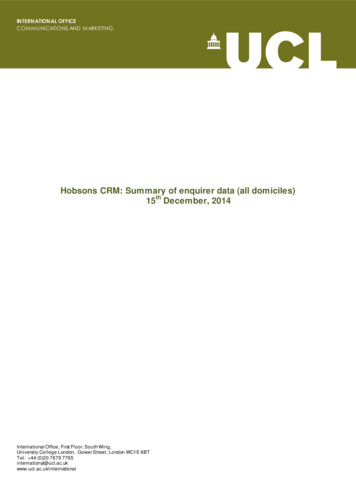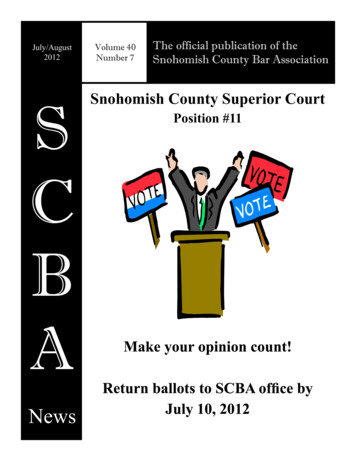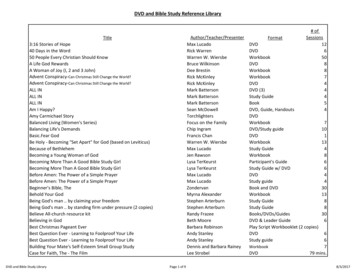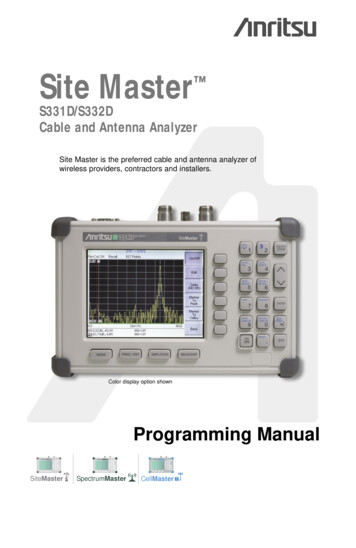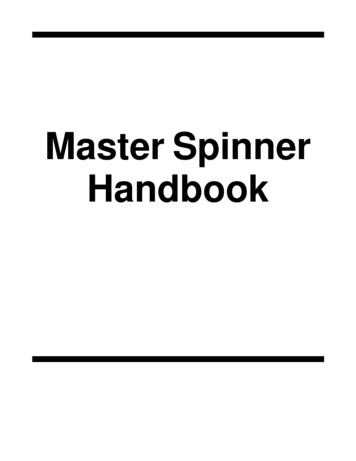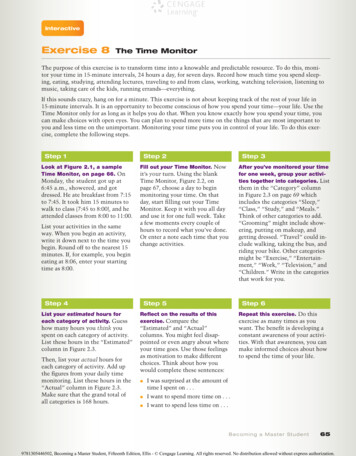
Transcription
InteractiveExercise 8The Time MonitorThe purpose of this exercise is to transform time into a knowable and predictable resource. To do this, monitor your time in 15-minute intervals, 24 hours a day, for seven days. Record how much time you spend sleeping, eating, studying, attending lectures, traveling to and from class, working, watching television, listening tomusic, taking care of the kids, running errands—everything.If this sounds crazy, hang on for a minute. This exercise is not about keeping track of the rest of your life in15-minute intervals. It is an opportunity to become conscious of how you spend your time—your life. Use theTime Monitor only for as long as it helps you do that. When you know exactly how you spend your time, youcan make choices with open eyes. You can plan to spend more time on the things that are most important toyou and less time on the unimportant. Monitoring your time puts you in control of your life. To do this exercise, complete the following steps.Step 1Look at Figure 2.1, a sampleTime Monitor, on page 66. OnMonday, the student got up at6:45 a.m., showered, and gotdressed. He ate breakfast from 7:15to 7:45. It took him 15 minutes towalk to class (7:45 to 8:00), and heattended classes from 8:00 to 11:00.List your activities in the sameway. When you begin an activity,write it down next to the time youbegin. Round off to the nearest 15minutes. If, for example, you begineating at 8:06, enter your startingtime as 8:00.Step 2Step 3Fill out your Time Monitor. Nowit’s your turn. Using the blankTime Monitor, Figure 2.2, onpage 67, choose a day to beginmonitoring your time. On thatday, start filling out your TimeMonitor. Keep it with you all dayand use it for one full week. Takea few moments every couple ofhours to record what you’ve done.Or enter a note each time that youchange activities.Step 4After you’ve monitored your timefor one week, group your activities together into categories. Listthem in the “Category” columnin Figure 2.3 on page 69 whichincludes the categories “Sleep,”“Class,” “Study,” and “Meals.”Think of other categories to add.“Grooming” might include showering, putting on makeup, andgetting dressed. “Travel” could include walking, taking the bus, andriding your bike. Other categoriesmight be “Exercise,” “Entertainment,” “Work,” “Television,” and“Children.” Write in the categoriesthat work for you.Step 5Step 6Repeat this exercise. Do thisList your estimated hours foreach category of activity. GuessReflect on the results of this exercise. Compare thehow many hours you think youspent on each category of activity.List these hours in the “Estimated”column in Figure 2.3.“Estimated” and “Actual” columns. You might feel disappointed or even angry about whereyour time goes. Use those feelingsas motivation to make differentchoices. Think about how youwould complete these sentences:Then, list your actual hours foreach category of activity. Add upthe figures from your daily timemonitoring. List these hours in the“Actual” column in Figure 2.3.Make sure that the grand total ofall categories is 168 hours. exercise as many times as youwant. The benefit is developing aconstant awareness of your activities. With that awareness, you canmake informed choices about howto spend the time of your life.I was surprised at the amount oftime I spent on . . . I want to spend more time on . . . I want to spend less time on . . .B e co m i n g a M ast er St udent659781305446502, Becoming a Master Student, Fifteenth Edition, Ellis - Cengage Learning. All rights reserved. No distribution allowed without express authorization.
9 /12MONDAYGet upShower7:007:15 Breakfast7:307:45 Walk to classEcon 18:008:158:308:459:009:159:309:45Bio 0Lunch12:1512:3012:451:00Eng. Lit1:151:301:452:002:15 57:009 12:1512:3012:451:00Lunch1:151:301:45Work2:00on 004:154:304:45Dinner5:005:155:305:456:00 Letter to6:15 Uncle Jim6:306:457:00Figure 2.1 Sample Time Monitor66Ch apter 2 T ime9781305446502, Becoming a Master Student, Fifteenth Edition, Ellis - Cengage Learning. All rights reserved. No distribution allowed without express authorization.
MONDAY / / ESDAY / / DNESDAY / / URSDAY / / gure 2.2 Your Time MonitorB e co m i n g a M ast er St udent679781305446502, Becoming a Master Student, Fifteenth Edition, Ellis - Cengage Learning. All rights reserved. No distribution allowed without express authorization.
FRIDAY / / TURDAY / / NDAY / / gure 2.2 (Continued)68Ch apter 2 T ime9781305446502, Becoming a Master Student, Fifteenth Edition, Ellis - Cengage Learning. All rights reserved. No distribution allowed without express authorization.
WEEK OF / / /CategoryEstimated HoursActual HoursSleepClassStudyMealsFigure 2.3 Your Estimated and Actual HoursInteractiveJournal Entry 6Discovery/Intention StatementDiscover the impact of technology on your timeMany students find that the Internet becomes a major time drainer. Discover whether this is true for you. Forone day, keep track of how much time you spend online. Use a simple system for gathering data. For instance,keep a 3 3 5 card and pen handy. On this card, write down the times when you start using the Internet andwhen you stop. Another option is to use a web-based time tracker such as SlimTimer (slimtimer.com) or Rescuetime (rescuetime.com).If possible, include short descriptions of how you spent your online time. For example: visit Facebook, check e-mail, read the news, do course work, or watch videos. After monitoring your online time, complete the following sentences:I discovered that the number of minutes I spent online today was . . .The things that I did online were . . . Next, think about any changes that you want to make in the amount of time you spend online. For example,you could close your web browser for defined periods each day. Complete the following sentence:I intend to . . . B e co m i n g a M ast er St udent699781305446502, Becoming a Master Student, Fifteenth Edition, Ellis - Cengage Learning. All rights reserved. No distribution allowed without express authorization.
Becoming a Master Student 65 The purpose of this exercise is to transform time into a knowable and
